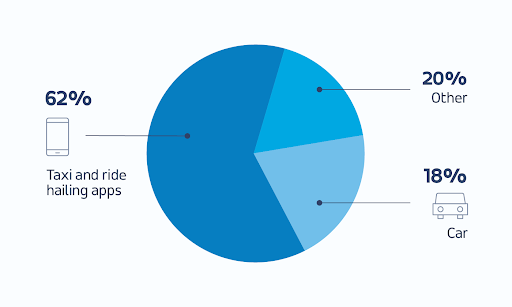Welcome to our Microtransit Misconceptions series, where we use detailed data and real transit examples to debunk common myths about on-demand public transit. Let’s dive in:
MYTH: People like the predictability of fixed route schedules. On-demand is just the wrong solution.
REALITY: Our experience around the world has demonstrated that well-run, well-scoped services are embraced by users of all ages and demographics.
We’ve worked with partners to introduce on-demand systems in a range of settings, including replacing manually-managed “dial-a-ride” services , replacing fixed route services, or adding a new public transportation option on top of existing services. In all cases, we work closely with partners to understand exactly what passengers will need in the service and then adapt our technology to provide it.
When cities transition fixed bus routes to on-demand services, we find that riders are happy to have a more convenient transport option than before. As passengers get used to an on-demand system, they quickly learn when to “order” their bus and, in any scaled service, find that the wait time will be very consistent day in day out. They also come to value the flexibility and control microtransit networks give them. 80% of on-demand passengers were not using public transportation for their journeys, but had started doing so when a good on-demand option was available. In many paratransit services, riders rely on on-demand systems to get them to and from medical appointments where it is crucial that they arrive and depart on time, and they can feel nervous about a new solution when it first launches. But Via riders have the option to book seats in advance by indicating whether they want to “depart at” or “arrive by” a specific time. This can instill more trust in the system than a traditional bus schedule or old dial-a-ride service would.
And beyond appealing to existing bus users, microtransit also opens up public transit to entirely new riders.

A survey conducted by the National University of Brasilia in June 2019 found that 80% of the new CityBus 2.0 service’s riders came from single-occupancy vehicles — including taxis and ridehail apps (62%) and personal vehicles (18%). That means 80% of on-demand passengers were not using public transportation for their journeys, but had started doing so when a good on-demand option was available.
Since COVID-19 became a concern, passengers also often deeply value the guarantee of a safe, socially-distanced place to sit on the bus, with clear records of everyone else who traveled with them.
It’s always easy to find a reason not to add technology to existing infrastructure, but when it comes to 21st-century public transportation, the status quo just isn’t working. Many of the worries around on-demand are rooted in myths and misconceptions that prevent the worldwide transportation community from making necessary progress. If we’re serious about connecting all households to the services they need, addressing COVID-19 challenges, mitigating climate change, and preventing massive congestion and pollution in our cities, now is the time for new ideas.
This article is one of five data-driven stories debunking common misconceptions about microtransit:
- On-demand public transit is too expensive.
- Cities have already tried on-demand transit, and it failed.
- On-demand isn't new — you've just stuck an app on it.
- People prefer the predictability of fixed route transit networks.
- App-based transit means people without smartphones miss out.




